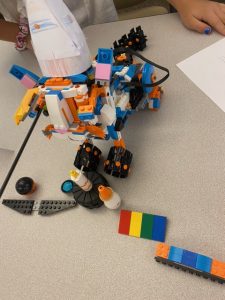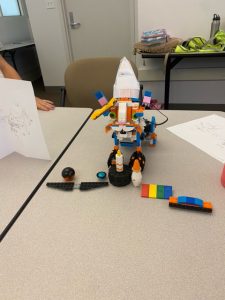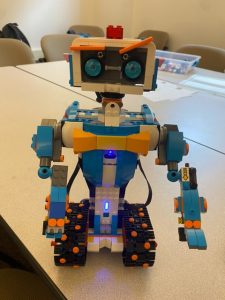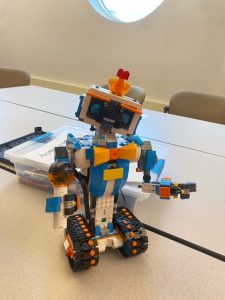Summer SAVY 2022/Session 4 – Programming and Robotics for Rising 3rd/4th Grade
Friday: We were in full programming mode on our last day! These programmers know how to use their new vocabulary, so not only can they walk the walk, but they can also talk the talk. They put together all of the skills they acquired this week and developed a fun program in the sprite lab. It was so fun for them to present their programs to the class. They can log into code.org on a computer at home and continue this lesson if they did not finish
The day continued with an official group meeting to present their Lego Robotics. Each group had to answer the following questions:
What physical features does your robot have that makes it move?
What sensors does it have? Why does it need the sensor?
How did you program it to move?
What else do you want to share about your robot?
Programmers independently adjusted their programs after failures and made design improvements after each try. The teamwork was the most impressive, especially when things were frustrating. I was amazed by the intuition, work ethic, motivation, and depth of thought that these programmers exhibited throughout the week. I hope they continue to enjoy programming and it inspires them to take the initiative to learn more on their own.
Tonight ask your programmers:
What did you program your Lego Boost to do that made it move successfully, such as a start block?
What did not work well for your robot during programming that you had to change?
What was your favorite thing about the week at programming and robotics?
Thursday: Today we started the difficult journey to conquer conditionals. This process requires problem solving using sequential true/false statements. We played a card game that had rules written in conditional format. To do this we practiced “if…then…” statements and added more conditionals with “if….else….” Such as “If (red card drawn) your team gets a point. Else (red card not drawn) other team gets a point. This is an advanced skill that can be difficult to pick up. I am really proud of the perseverance I have seen while working on puzzles with conditionals.
The most exciting part of the day was when they engineered new features for their Lego Boost robots. Some groups built a human-like robot that moved with a belt system and others created a robot that had a belt with sensors similar to what you would see in warehouses. I am thrilled with their ability to make connections to other industries! They were all excited about the guitar concert that played sounds according to color and the cat that could move its eyes
Tonight ask your programmers:
Why are conditionals important to a program?
How was the machine robot on quick draw able to guess your pictures?
What was one puzzle on code.org that you struggled with today?
How does your team communicate while building the Lego robot?
Wednesday: What a day of programming! We have filled our brains with new vocabulary this week and it is imperative to use it while we code, so we started the day with a vocabulary review game. Then, we continued reading The Wild Robot Escapes by Peter Brown to inspire futuristic thinking for the rest of the day. Developing functions within our programs was the skill we added to our coding knowledge today. The programmers are really pushing their critical thinking skills to the max and showing perseverance when working through the difficult puzzles.
The day concluded with the groups continuing to build their Lego Boost. The programmers built features on the robots before they programmed them to move.
Tonight ask your programmers:
What are the benefits of using functions?
What was one puzzle on code.org that you struggled with today?
Tuesday: Today these programmers learned that their job isn’t always creating new technology. They became aware that a big part of their job description is fixing or “debugging” programming problems. We started the day reading more of Peter Brown’s, The Wild Robot Escapes, to put our brains in the futuristic mindset of the world of robots. We continued developing our collaboration skills with a lesson on perseverance and frustration. The students worked together to engineer a structure built out of toothpicks and gumdrops that could hold up a book for at least 10 seconds.
While learning more about coding, we leveled up with a lesson on looping actions that we need our robot to perform. A loop is the action of doing something over again, or a synonym of repeat. We looped code together instead of repeating the steps over and over again. First, we investigated this process with an unplugged (no technology) activity. Programmers wrote a code to build a model of stacked cups for their robot friends to follow. Instead of repeating the same steps, they problem solved to loop them together to save time. We pushed ourselves further by trading our paper codes with other teams to decode any problems. We were introduced to new vocabulary and new blocks to use while coding. These new skills were transferred to the code.org platform where the programmers identified repeating patterns with multiple steps and applied nested loops within our programs. But we didn’t stop here! These programmers learned to draw with their characters as we focused on measuring angles in degrees and measuring movement in pixels.
Continuing with our theme of robots in the workplace, we studied new technology. We watched a video of a robot in Singapore that picks up an ice cream cup, pours a perfect cup of ice cream, adds toppings, and places it on a tray for pickup. To study this robot system, we completed a systems chart and found the inputs, boundaries, elements, interactions, and outputs. The best part of the discussion was when we answered the question, “How could sensor data be used with “AI” to avoid a mishap?” These programmers brought lots of excitement and critical thinking to what mishaps could occur and how “AI” could solve them.
Our day concluded with the best part: building our robots. Teams used all of their concepts of inputs, interactions, elements, outputs, boundaries, coding, engineering, collaboration, perseverance and all other things mathematics I forgot to mention, to construct a human like robot. I am so proud at how much our team building skills have improved in just 2 short days together. They progressed much faster through the building process than the day before. These robots take time to put together, but they are still very focused and excited!
Tonight ask your programmers:
Why do you need to know angle measurements to code characters to turn?
What is a nested loop and how does it help you while programming?
Why is it important to know how to “debug” programs?
Why is it important for programmers to persevere?
Monday: These programmers had a great first day conceptualizing the world of robotics! We started by reading the first page of Peter Brown’s best seller, The Wild Robot Escapes. This allowed us to discuss how robots know what tasks to perform. The students transferred these skills to using blockly coding on code.org. They were able to learn a language to communicate with their robot (computer character) to complete tasks. This also highlighted the importance of critical thinking and debugging or fixing errors. We were introduced to the sprite lab, and no, it’s not a lab full of Coca-Cola Sprites. A sprite in programming is a graphic character on the screen with properties that describe its location, movement, and look. The sprite lab was a light introduction to coordinate planes and the x and y axis. The sprite lab can be very difficult to maneuver and the blocks become much more advanced. I wanted to present it to give them an opportunity to see what is next in the world of code.
The overarching theme of the week focuses on the effects of robots in the workplace. Today we learned that AI or artificial intelligence makes it possible for machines to learn from experience, adjust to new inputs, and perform human like tasks. We listened to a short informational video that talked directly about AI in warehouses. Then, we watched a video and discussed how the company Amazon used robots in their warehouses. This allowed us to debate about the causes and effects of robots in the workplace and problem solve real world issues.
The most popular part of the day was combining our engineering skills and programming skills to build Lego Boost robots and have the robots complete small missions. As the week goes on, these missions will be harder. The most important aspect of the day is that these programmers learn to work together as team members. We are continuously talking about how to problem solve with others to create success!
Tonight ask your programmers:
What types of jobs the robots in the Amazon Warehouse were performing?
Was a human able to do that job before the robot?
Why do you think Amazon has robots filling orders?
What are the benefits and downfalls of robots in the workplace?
This is an amazing group of analytical thinkers and I cannot wait to see what we can develop together this week!






